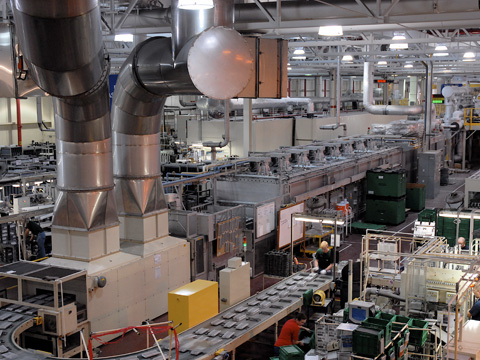Reclamation Fever

“Even on zero degree days, only five or so burners fired up and only at 5-10 percent capacity,” he says.
— Pat Carpenter, Facilities Engineer
Out on DENSO Manufacturing Michigan’s plant floor in Battle Creek, large furnaces tower among the assembly lines. These furnaces hum along nearly 24-hours a day, working their magic on partially assembled products, joining metals with their 1,000-plus-degree temperatures.
Step close to one of these furnaces and through the crisscrossing bars of the grate you can see the assembly line passing through the system and feel the heat that radiates within the belly of the furnace.
These furnaces generate a lot of wasted heat, and that is where the Heat Reclamation project comes in.
Above the furnaces, huge silver and beige ducts travel along the ceiling. Their presence is unremarkable to the average eye, blending with ceiling supports and myriad fixtures high above the plant floor.
However, these ducts perform a significant function: they take wasted heat from the furnaces, carry it upwards, circulate it with fresh air from the outside and transport it out to cooler areas of the plant. This process is called heat reclamation, and it is used to keep the plant warm during the frigid Michigan winters.
In the first year after DENSO Manufacturing Michigan’s heat reclamation project began, employees monitored the plant conditions daily. As part of the company’s original heating system, 37 burners throughout the facility were on standby, ready to fire up and heat the building as conditions demanded.
Yet according to Pat Carpenter, Facilities Engineer, after the heat reclamation equipment was installed and operational, on average only two or three burners were ever in use on chilly days, and only 17 percent of their capacity was needed.
“Even on zero degree days, only five or so burners fired up and only at 5-10 percent capacity,” he says.
The reclaimed heat was doing the job of heating the facility nearly on its own.
When the project began, a big aim for the Facilities department was to reduce utility cost. But as the team evaluated the impact it would have, they realized it would have a big effect on CO2 emissions as well.
The end result? The Battle Creek facility reduced its consumption of natural gas by more than 33 million cubic feet and its CO2 emissions by 3.9 million pounds – exceeding even DENSO’s ambitious global goals for CO2 reduction.
The wheels of progress have long turned with power generated from fossil fuels. But as supplies decline and concern about greenhouse gases increases, industry will define progress not just by the products DENSO produces, but by the by-products it doesn’t produce and the resources it conserves and protects. DENSO takes that challenge seriously.
The heat is on…and DENSO Manufacturing Michigan stands ready to reclaim it.
Feature Story: As the Worm Turns
